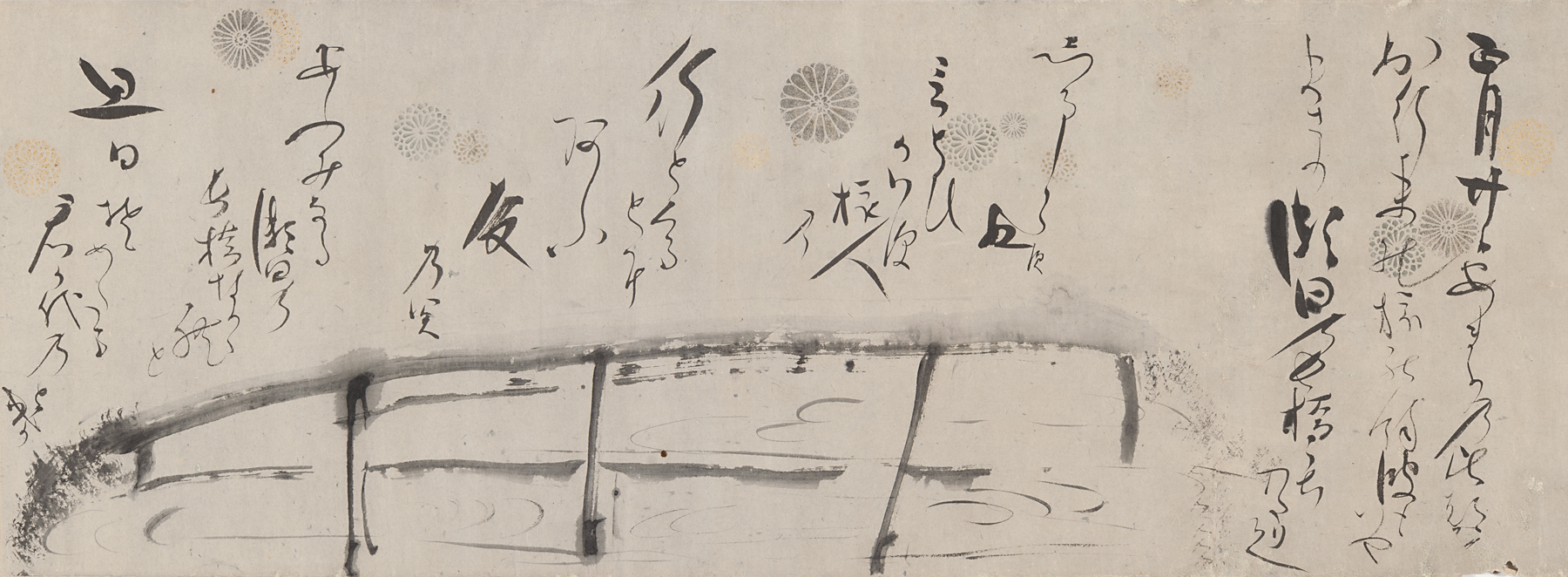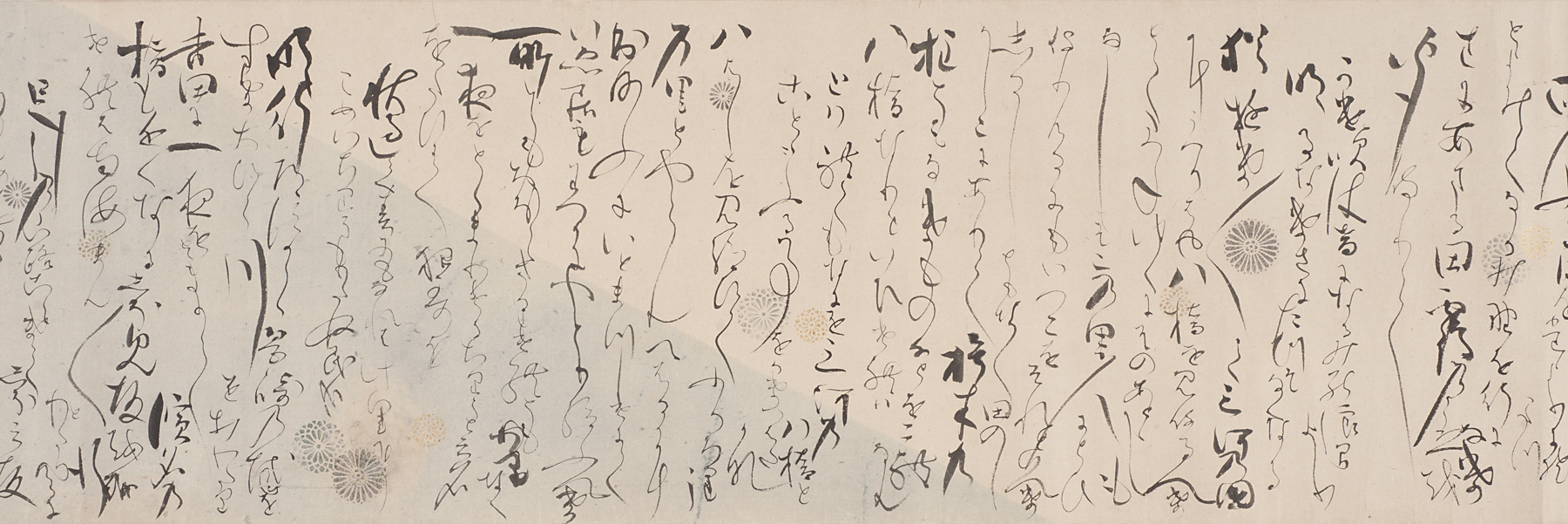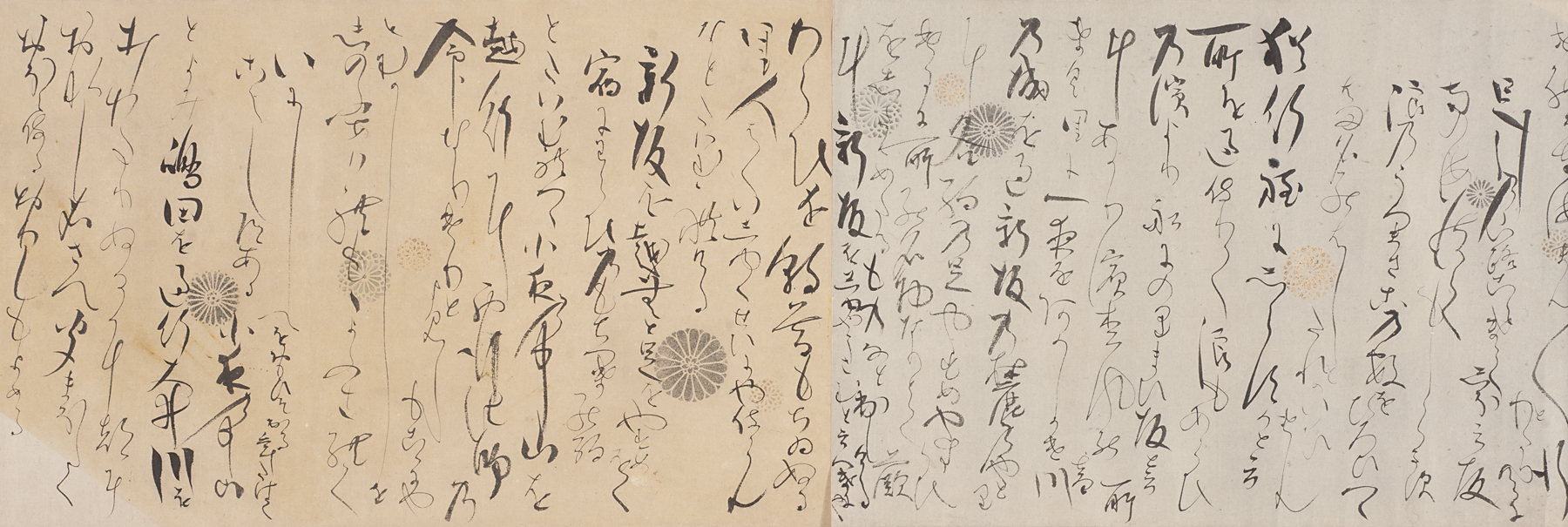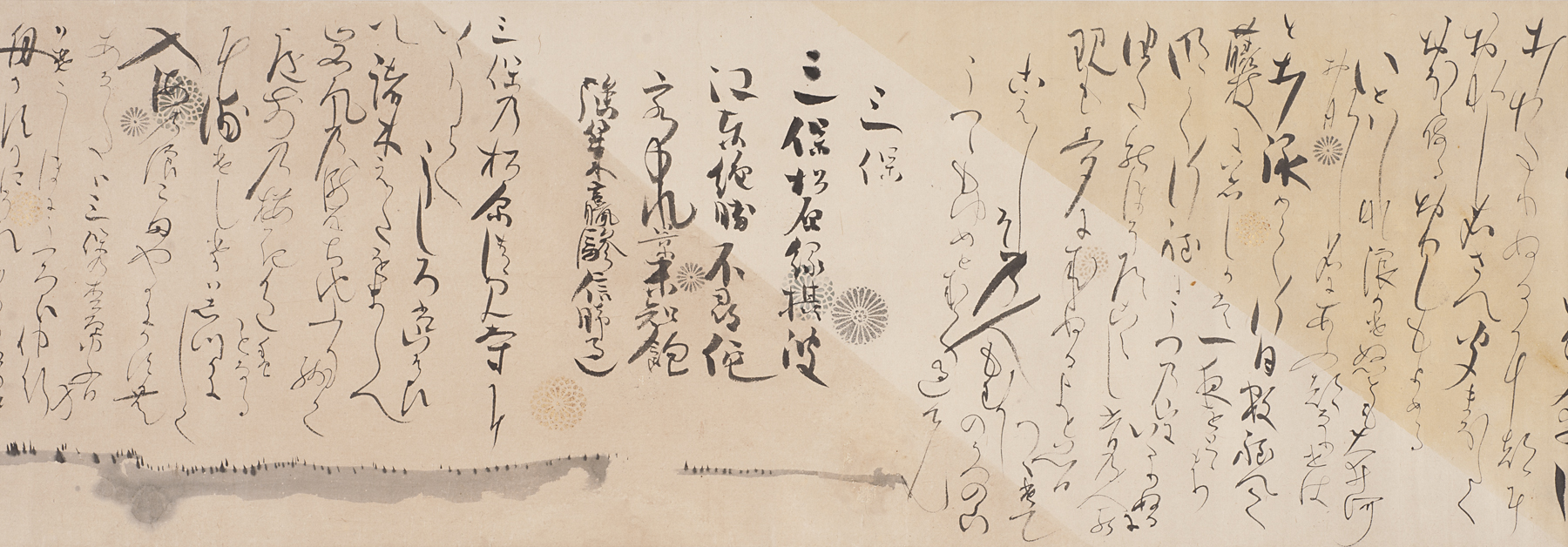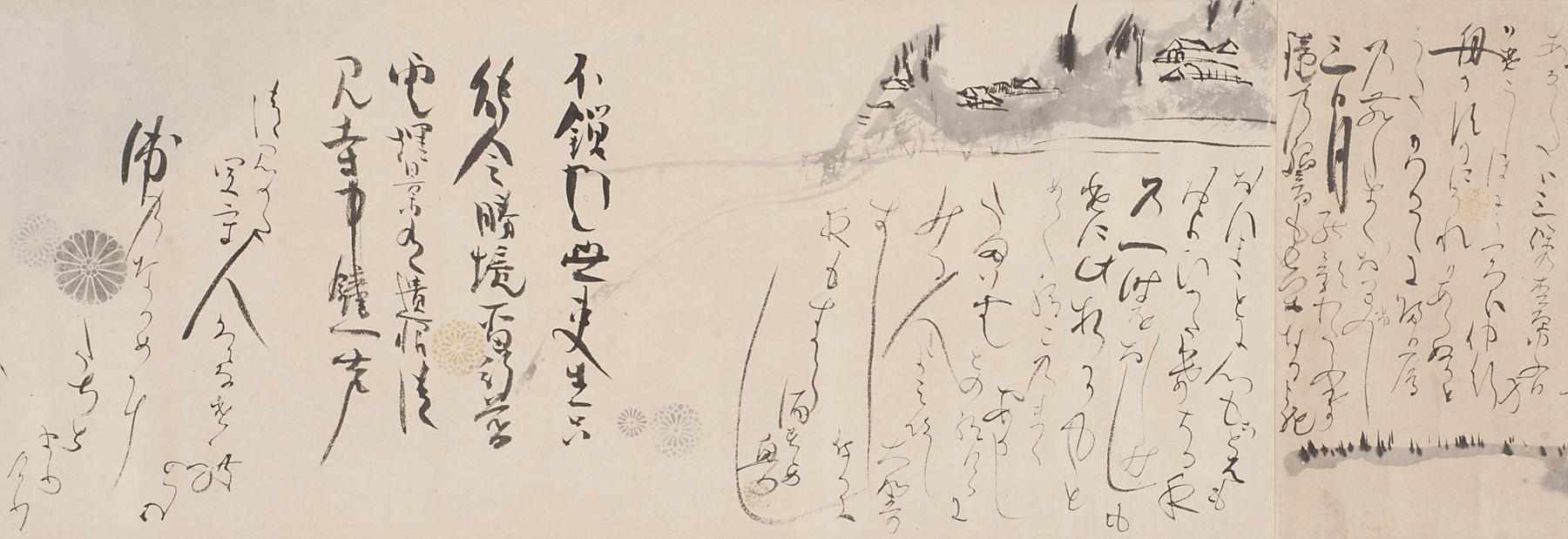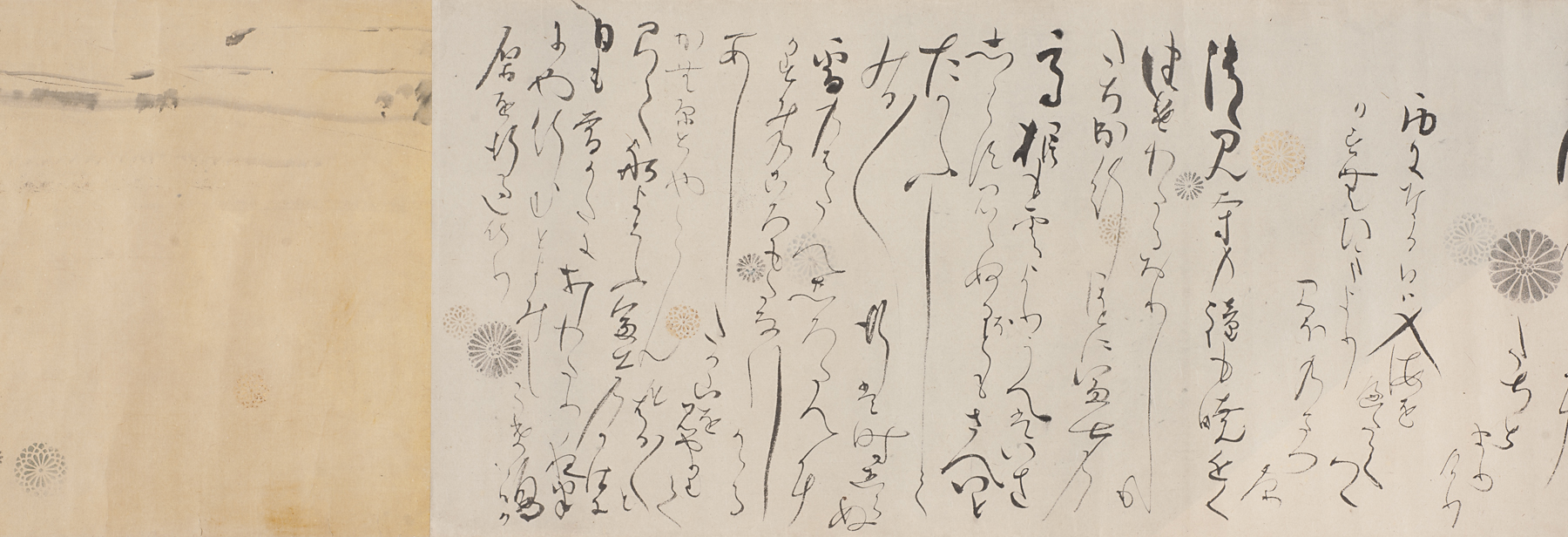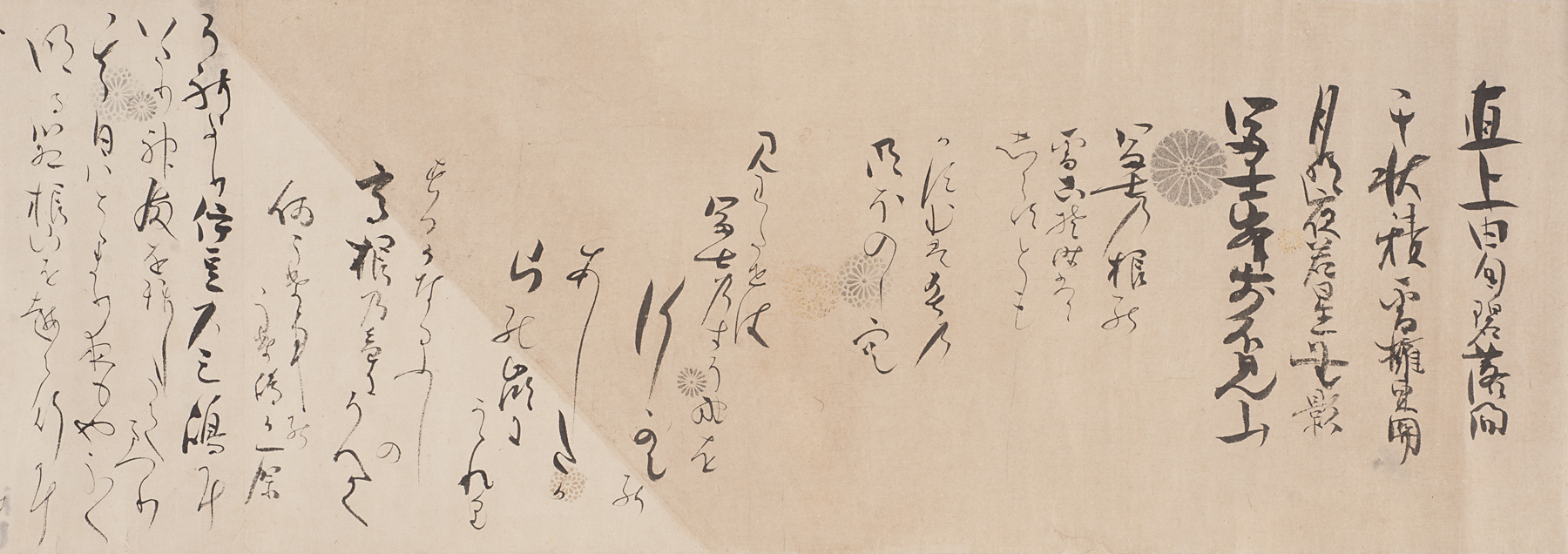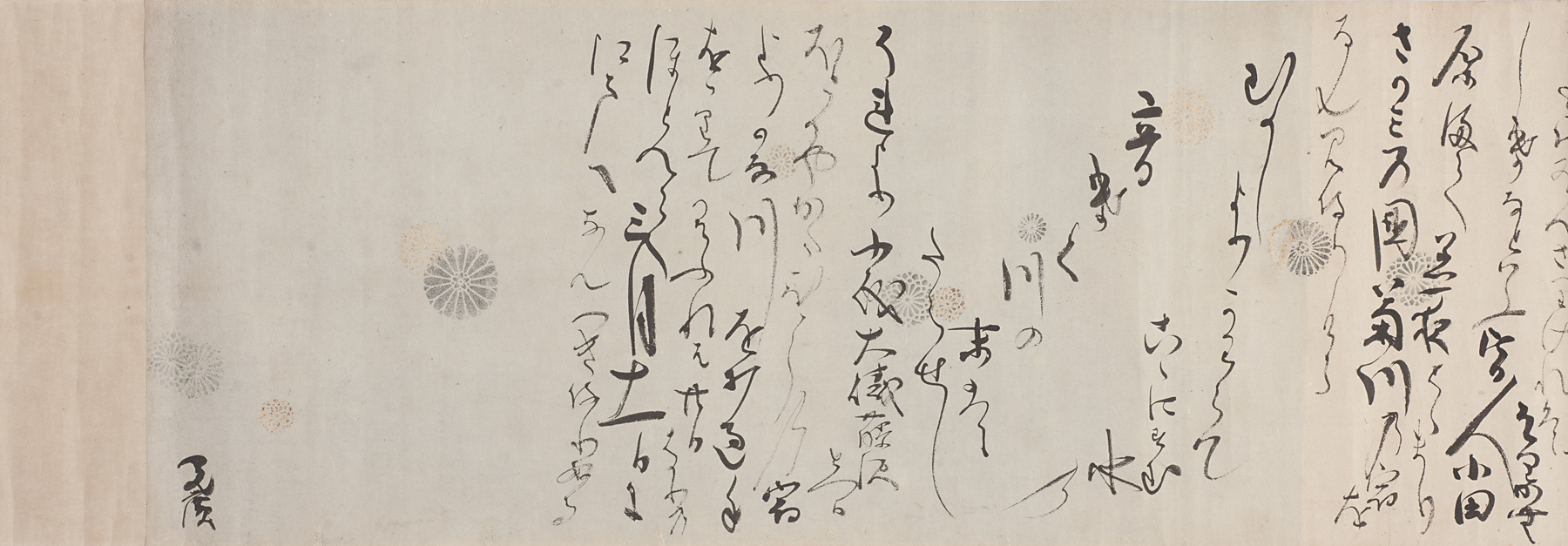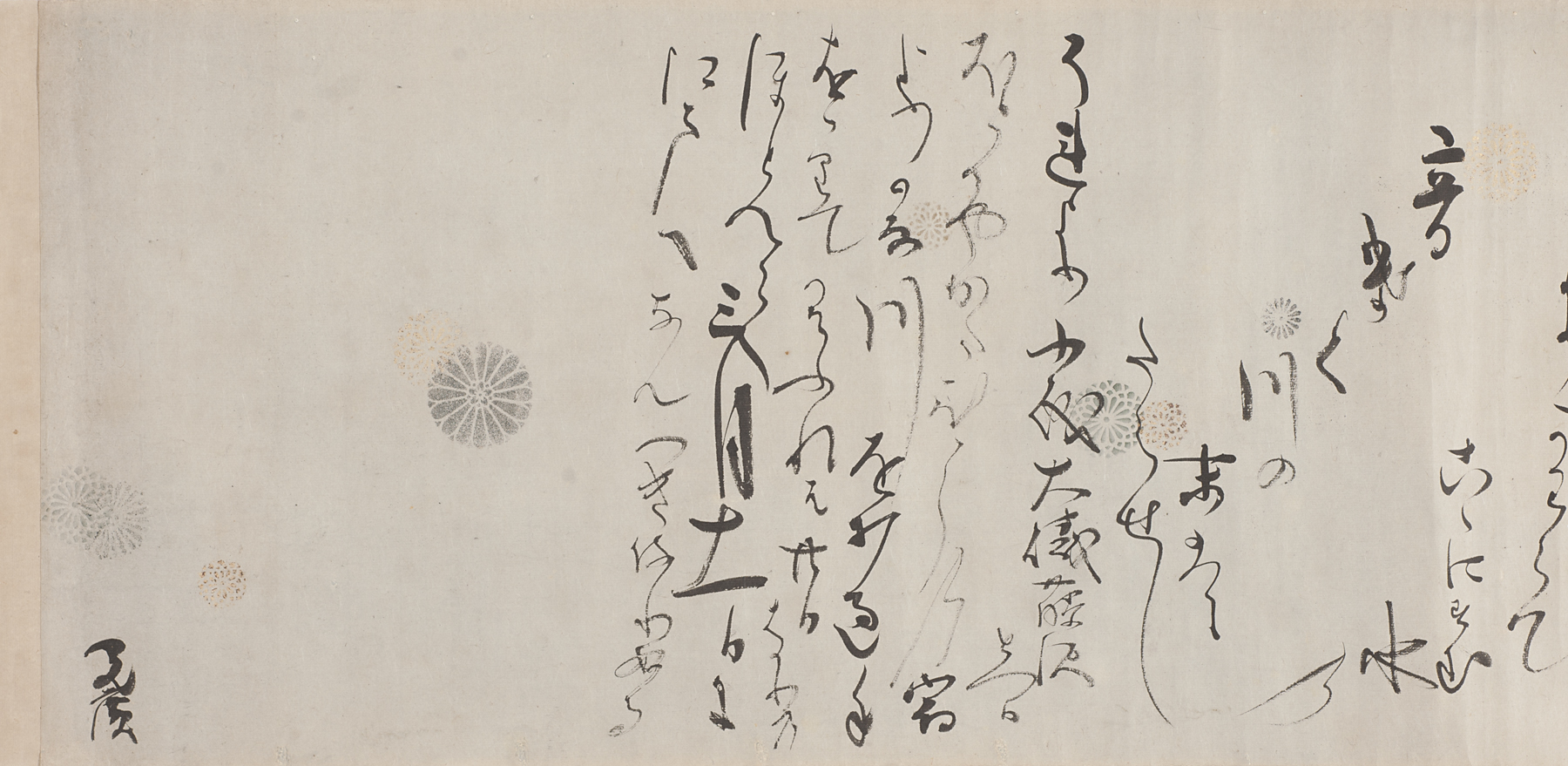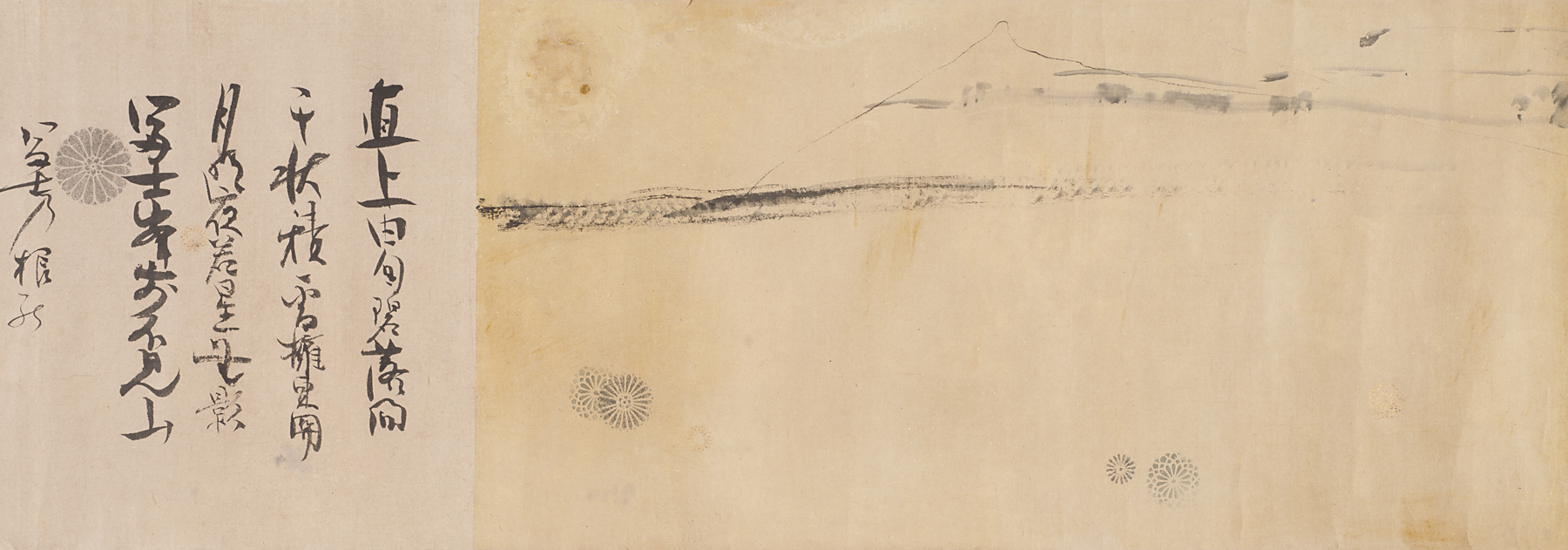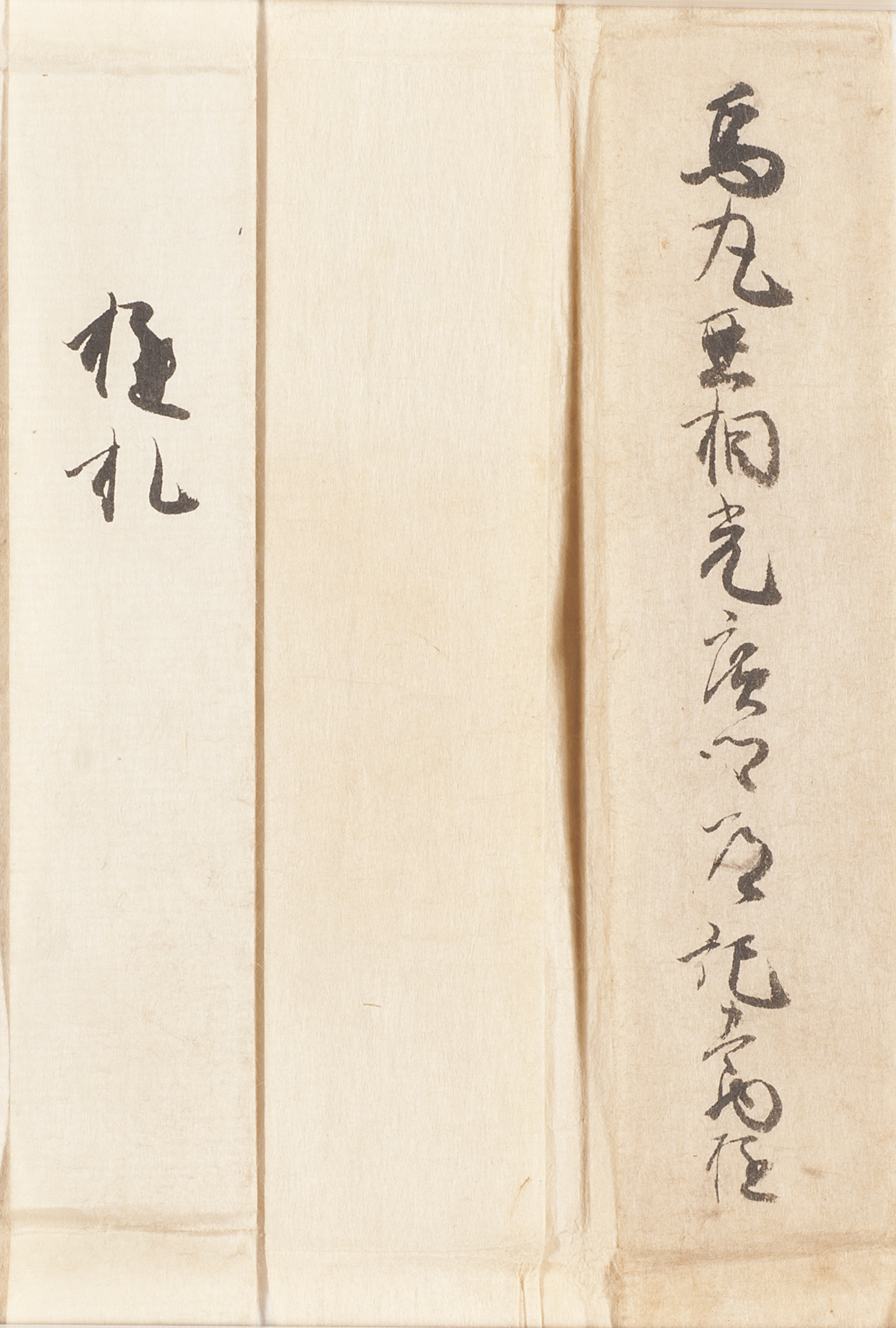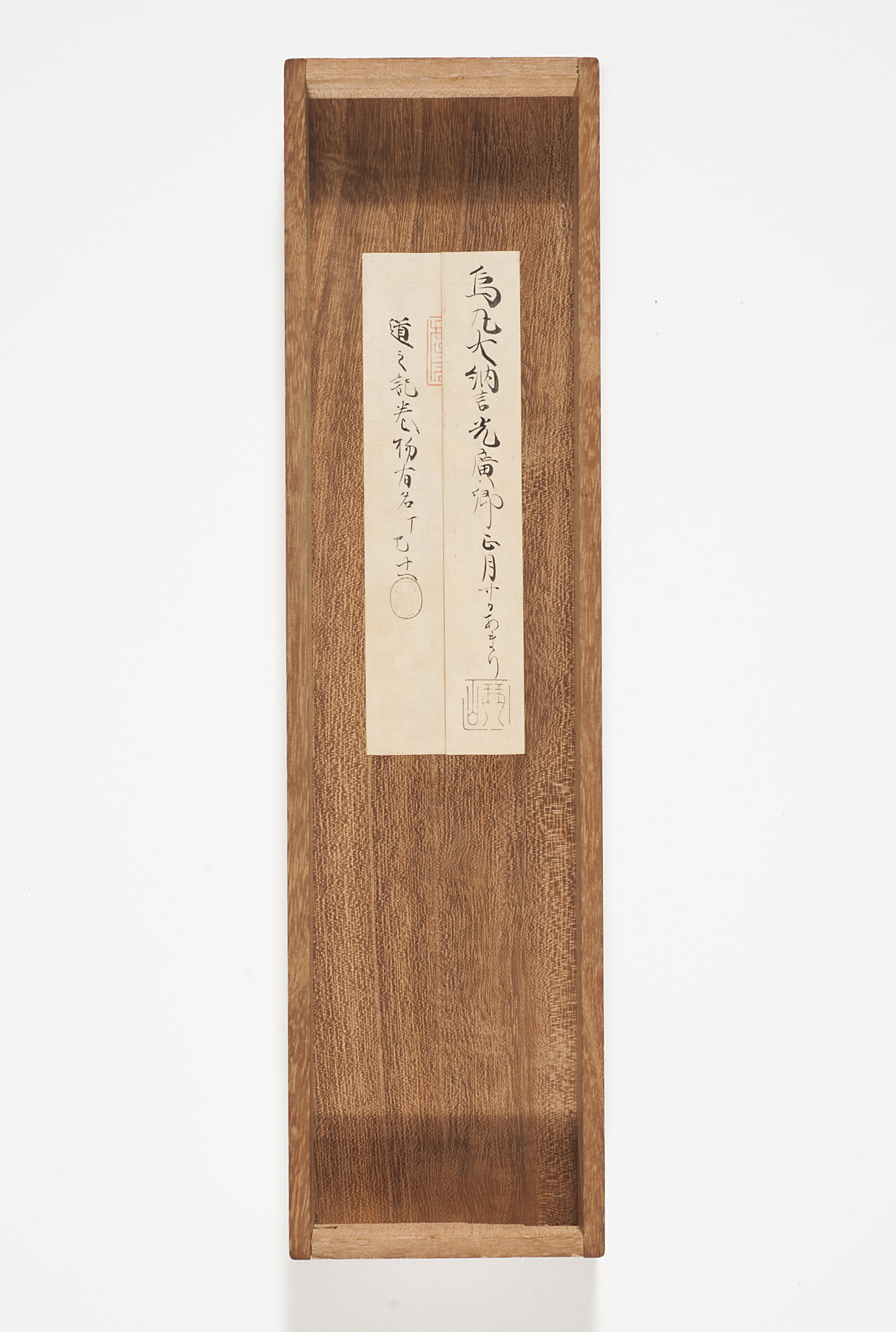Teaching Gallery Label:
"The Tea Ceremony," Apr-2014, Kris Imants Ercums
Mitsuhiro was a high-ranking courtier and a leading poet of the early 17th century. He synthesized the calligraphic traditions of several important schools to produce his own lively style that recalled the aesthetics of the Heian period, such as dyed papers decorated with silver and gold and calligraphy written in the native cursive style. The scroll is a poetic record of Mitsuhiro’s journey between Kyoto and Edo (present-day Tokyo). It opens with the passage: ”Around the 20th of the first month, I departed for Tokyo…and crossed the Nagabashi bridge at Seta,” followed by two poems, and a dramatic rendition of the Nagabashi bridge in the village of Seta just outside Kyoto. The text, drawings, and poems recount Mitsuhiro’s journey along the 307 mile Tōkaidō (Eastern Sea Route) leading from Edo (Tokyo), the home of the Shogun, to Kyoto, site of the emperor’s palace. The poems include both waka written in the native kana syllabary and Sino-Japanese verses brushed using more angular and complex characters.
Archive Label 2003 (version 1):
Around the 20th of the first month, I departed for Tokyo…and crossed the Nagabashi bridge at Seta.
This scroll is a poetic record of Karasumaru Mitsuhiro’s journey between Kyoto and Edo (Tokyo). It opens with the passage quoted above, two poems, and a dramatic rendition of the Nagabashi bridge in the village of Seta just outside Kyoto.
Mitsuhiro was a high-ranking courtier, poet, and renowned calligrapher. His idiosyncratic style recalled the aesthetics of court culture during the Heian period (794-1185) as does his use of dyed papers decorated with silver and gold.
Archive Label 2003 (version 2):
The acquisition of this scroll was a coup for the museum. The scroll is of such importance to the history of Japanese art that it required more than a year and a half to prevail on the Japanese Agency of Cultural Affairs to allow its export. In order to convince the agency, Dr. Patricia Fister, the former curator of Asian Art, explained the important role the Spencer Museum of Art plays in the dissemination of knowledge about Japanese art. She also brought photographs to Japan, showing the care with which the museum displays its Asian art. Finally, the cultural representative was convinced that the Spencer Museum would be a worthy recipient of this precious testament to the beauty of Japanese art.
Mitsuhiro was a high-ranking courtier and a leading poet of the early 17th century. He synthesized the calligraphic traditions of several important schools to produce his own lively style that recalled the aesthetics of the Heian period, such as dyed papers decorated with silver and gold and calligraphy written in the native cursive style.
The text, drawings, and poems recount Mitsuhiro’s journey along the 307 mile Tōkaidō (Eastern Sea Route) leading from Edo (Tokyo), the home of the Shogun, to Kyoto, site of the emperor’s palace. The poems include both waka written in the native kana syllabary and Sino-Japanese verses brushed using more angular and complex characters.
Exhibition Label:
"Selections for the Summer," Jun-2006, Mary Dusenbury
Around the 20th of the first month, I departed for Edo...and crossed the Nagabashi bridge at Seta....
Karasumaru Mitsuhiro began his poetic record of a journey between Kyoto and Edo (present-day Tokyo) with this statement and a dramatic illustration of the “Long Bridge“ (Nagabashi) in Seta just outside Kyoto. He continued with thirty feet of poems and sketches on paper decorated with dyed washes and gold and silver foils.
Mitsuhiro was a high-ranking courtier who served as a liaison between the imperial court in Kyoto and the ruling military shogunate in Edo. He was renowned as a poet and calligrapher whose style and use of decorated papers recalled the aesthetics of court culture during the classical Heian period (794-1185).
Two centuries later, print artists such as Hiroshige (see print above) delighted in depicting travel along the Tōkaidō Road that stretched between Kyoto and Edo. In the print above, Hiroshige has also illustrated the Nagabashi that marked the beginning of the two-week journey to Edo.
Archive Label:
Mitsuhiro was a high-ranking courtier and a leading poet of the early 17th century. He synthesized the calligraphic traditions of several important schools to produce his own lively style that recalled the aesthetics of the Heian period (794-1185). Those aesthetics included papers dyed and decorated with silver and gold and, most importantly, calligraphy written in the native cursive style. This scroll is a record of Mitsuhiro's impressions of a journey on the Tōkaidō Road from Edo (Tokyo) to Kyoto. It contains many poems that Mitsuhiro composed along the way, including waka written in the native kana syllabary, Chinese-style verses brushed using more angular and complex characters, as well as tiny landscape sketches.
